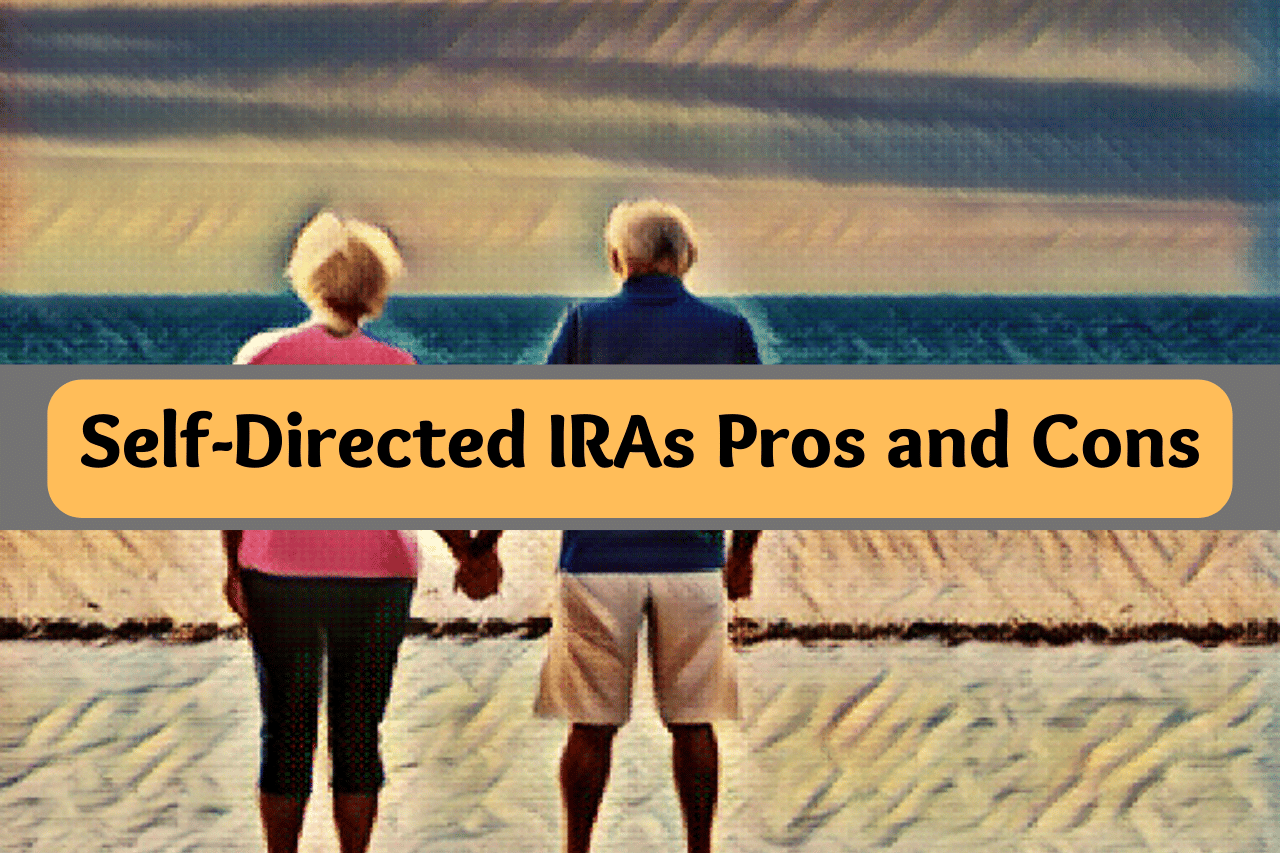A retirement plan ensures better financial security while also helping your money grow. The individual retirement account plan or IRA is one such plan that gives you good returns in a tax-advantaged way.
But there are more than just traditional IRAs to have this advantage. A Roth self-directed IRA or SDIRA is a particular category of IRA that offers investors more control. In the case of an SDIRA, you can directly manage your investments without relying on financial institutions.
This article will explain the pros and cons of self-directed IRA investment and how you can use the plans for your retirement.
What is a self-directed IRA?
A self-directed individual retirement account or SDIRA is an investment vehicle that gives you various alternative investment opportunities. The self-directed IRAs can be availed either in the form of a traditional IRA or a Roth IRA.
It may have similar contribution limits to the IRA but allows investments that might not be available in regular IRAs. However, the rules of SDIRA are complicated, and the risks are higher!
But so are the benefits.
What are the benefits of a self-directed IRA?

If you are looking for greater flexibility in the investment opportunities of your disposable and discretionary income, then SDIRA is an excellent choice. It offers many benefits, like built-in tax breaks, choice of higher potential investments, and diversification.
Up-front tax break
Sure, you get tax advantages on all your retirement plans! But with a self-directed IRA, you get an up-front tax break. You will not have to pay any taxes until you withdraw the money because all contributions in SDIRA are tax-deductible. This can save you from the higher tax bills while also saving you from the upfront tax deduction.
Diversification
Who wouldn’t want to diversify their portfolio? It reduces the risk of market volatility while allowing you to gain the advantage of different investment tools. This is crucial for your retirement assets.
But regular IRAs limit your choices, providing only low-return stocks and bonds. If the market collapses, this could jeopardize your financial situation. You can avoid these risks by widening your investment reach with a self-directed IRA.
Checkbook control
You can invest in SDIRA using a simple check since you have complete control of the funds. Of course, you can also use a debit card or wire transfer facilities. But the more important thing is that you need to seek bank permission.
What are the drawbacks of a self-directed IRA?
Despite its many benefits, SDIRAs have certain drawbacks that you must be aware of before investing. Since the returns are high, you can always expect higher risks while investing in a self-directed IRA. Apart from this, there are some other cons as well.
Complicated regulations and paperwork
To receive the SDIRA savings account's tax advantages, you must properly adhere to all the IRS regulations.
It is usually the financial institution's job to ensure everything is in line. But with SDIRA, you have much more control than the regular IRA. This puts you at greater risk of non-compliance. In such cases, your self-directed IRA can get disqualified, and you may even have to pay taxes and penalties.
So, you must make yourself aware of all the rules and regulations of financing, managing, and selling properties before making SDIRA investments. You would also have to perform a lot of tedious paperwork while creating the SDIRA and get the custodian countersigned on all contracts. The worst part is that there are some fees you cannot avoid.
The hidden cost of investment
Certain investments through the SDIRA, for example, real estates, tend to be high-cost. This is because closing costs are added to the property's price. If you invest in expensive properties, this can put the pressure of a hefty additional amount on you.
Other than this, there are other costs, like down payment, taxes, mortgage, homeowner’s insurance, and cost of repairs and maintenance.
This is why a self-directed IRA investment in real estate might not be the best choice, especially if you are short on liquid cash.
How do I set up a self-directed IRA?
Just because you have more control over your investments, that does not mean you have to manage the plan entirely by yourself. You would need the help of third-party services to manage a self-directed IRA. This could be a custodian, like the banks, or a trustee.
You can set up one in a few steps, as mentioned below:
⦁ Find a custodian for your SDIRA
⦁ Choose the investment types
⦁ Complete all the verification, investigation, and auditing
⦁ Find a broker who will help you with investment purchases
⦁ Ask your custodian or trustee to complete the transaction
Here, you must remember that not all institutions will provide a custodian for this type of IRA. This is because these financial institutions may offer other types of IRAs. So, do your research thoroughly before making any decisions.
What are the contribution limits for a self-directed IRA?
The contribution limit for SDIRAs is the same as regular IRAs. So, even if you have multiple IRAs, your contributions must be within this annual limit.
The annual contribution limit is up to $6000 for under-50 investors. For those above 50, the limit is $7000 annually.
What types of investments are allowed in a self-directed IRA?
While you can only access the stocks, bonds, and mutual funds in regular IRAs, SDIRAs let you invest in private companies and real estate.
You can also invest in promissory notes, tax lien certificates, precious metals like gold and silver, water rights, etc. The unique part of SDIRAs is that you can use the fund to invest in cryptocurrencies.
You can also invest in regular stocks, ETFs, and mutual funds.
What are the rules for withdrawing from a self-directed IRA?
Since self-directed individual retirement accounts (IRAs) are ultimately retirement accounts, you cannot withdraw before the stipulated period. If you try to do so, then there are penalties to pay.
You must be at least above the age of 59 ½ years to withdraw the fund without facing any retribution. You must also comply with the minimum distribution requirements once you turn 72.
Can I borrow against my self-directed IRA?
No, despite its versatility, you will not be able to use the self-directed IRA to get a loan. According to the IRS guidelines, your IRA seizes to be an IRA if you borrow from it.
However, in some cases, you may borrow a short-term personal loan against the SDIRA. You would have to take advantage of the “60-day rollover rule” in this case. But remember that you only have 60 days to pay off the loan, or there will be penalties.
What happens to my self-directed IRA when I die?
You can transfer the benefits of your hard-earned investment to the next generation through legacy planning. For this, you have to add them as beneficiaries in your self-directed IRA. Once you fill out the beneficiary designation form, you must check the information regularly to see that it does not end up in the wrong place.
If there is more than one beneficiary, you must clearly define how the funds should be distributed. There are a few plans and designs, like the per capita design, to help you with this.
Final Thoughts
Self-directed IRAs offer many benefits, especially for real estate and other non-traditional investment vehicles, such as secured notes, private equity, cryptocurrencies, and precious metals. But you must have the required knowledge and expertise to handle the complications and regulations of the process.
Please practice your due diligence and take your time. There are a variety of resources and organizations that help provide you with accurate and helpful information on retirement investing and avoiding scams within this space.
The SEC’s Office of Investor Education and Advocacy is a advocate to help educate the population of fraud associated with self-directed IRA products.
The North American Securities Administrators Association (NASSA) has published actionable information to help spot potential fraudalent schemes and avoid fraudsters targeting investors in the SDIRA market.
For any victims of self-directed IRA schemes, please reach out for legal assistance from firms that specialize in this area to help you recover any losses from investment & securities fraud. Silver Law Group can help answer any legal answers you have and provide advice. They can be contacted at (800) 975-4345.
The Retirement Industry Trust Association (RITA) is an excellent source for information on self-directed investing with retirement accounts to help ensure you aren't in violation of prohibited activities.
Once you become more educated on this space, this particular retirement investment tool can provide you with tax deductions and steady monetary growth to enjoy after retirement.
Frequently Asked Questions
⦁ How can a self-directed IRA be used for retirement?
The SDIRA allows you to invest in alternative or exotic assets that can provide better financial gains after retirement.
⦁ Who is eligible to open a self-directed IRA for retirement?
Anyone can open an SDIRA with any financial institution, given they provide the alternative investment opportunity. Despite having the most control, you will still need a custodian or trustee for your account.
⦁ What is a self-directed IRA for retirement?
It's a 401 (k) plan where you find an administrator, trustee, or custodian that allows you to govern your investments.
⦁ Where can I open a self-directed IRA for retirement?
You can open one with any custodian offering alternative investment opportunities. For instance, Equity Trust, the Entrust Group, IRA Financial, Madison Trust, etc., are some IRA eligible custodians. From their, if you would like to invest in silver and gold, you can open a precious metals IRA with our Top-Rated Gold IRA company of choice, Augusta Precious Metals.
<<Sign Up for a Silver IRA FREE Web Conference Today!>>
Risk Disclosure: Any investments come with an inherent risk, where you could end up making less money than what you put in. Before investing your hard-earned cash, be sure to speak with licensed professional financial advisor first. Always remember that past performance is not an indication of future returns.
Disclaimer: This website's owners may be compensated for suggesting certain businesses, goods, and services. While we do everything possible to verify that all of our content is accurate, the information we provide may not be impartial or unbiased, and it does not constitute financial advice.



